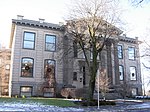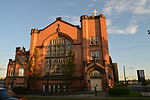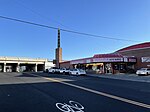Maple Street Bridge (Spokane)
1958 establishments in Washington (state)Bridges completed in 1958Buildings and structures in Spokane, WashingtonTransportation buildings and structures in Spokane County, WashingtonTransportation in Spokane, Washington ... and 3 more
Washington (state) building and structure stubsWashington (state) transportation stubsWestern United States bridge (structure) stubs

The Maple Street Bridge is a girder bridge in the northwest United States in Spokane, Washington. It spans West Central to Downtown, crossing over the Spokane River and the Peaceful Valley neighborhood. Along with the Division Street Bridge and Monroe Street Bridge, the Maple Street Bridge is one of several major bridges that cross the Spokane River.The bridge is 1,719 feet (524 m) in length, stands 125 feet (38 m) above the river, with a deck that is fifty feet (15 m) wide. It has two-lane traffic in both directions, and a caged pedestrian walkway. As of 2015, the Maple Street Bridge has an average daily traffic of 40,600 vehicles.
Excerpt from the Wikipedia article Maple Street Bridge (Spokane) (License: CC BY-SA 3.0, Authors, Images).Maple Street Bridge (Spokane)
North Maple Street, Spokane
Geographical coordinates (GPS) Address Nearby Places Show on map
Geographical coordinates (GPS)
| Latitude | Longitude |
|---|---|
| N 47.659444444444 ° | E -117.43472222222 ° |
Address
North Maple Street
North Maple Street
99201 Spokane
Washington, United States
Open on Google Maps











